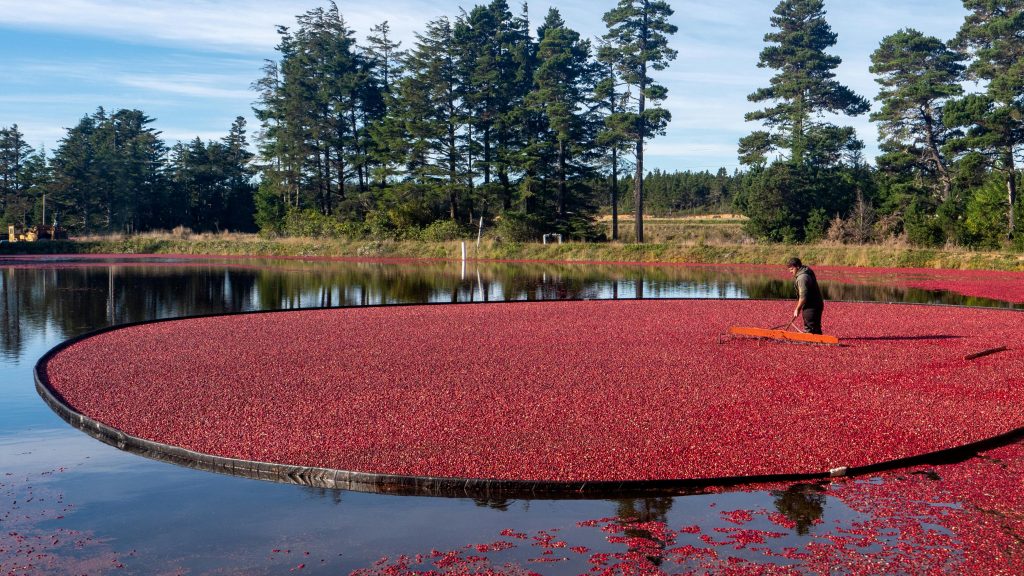Station Selected:

Cranberry Harvest: The Bitter Truth About The Cold
By Meteorologist Brittney MerlotMADISON, Wis. (CIVIC MEDIA) – Local cranberry farms find themselves in an icy situation, scrambling to protect their top crop in Wisconsin.
As Autumn hits, harvest is underway and farmers across the state say they have been pleased with the plant’s product this season. But this weeks cold overnights hurt the state’s cranberry farms.
The first hard freeze hit Wisconsin last week and it had local cranberry farms scrambling.
“Farming is very challenging.” said Senator Mazie Hirono of Hawaii. She says she made the trip to Wisconsin to help Senator Tammy Baldwin last week, because she goes straight to farms and listens. “To realize how much of it is produced here and the challenges you face is really important.”
Lake Nokomis Cranberries in Eagle River, is a fourth-generation family-owned cranberry farm.
“This is my 50th year on this farm.” said David Zowitowski, the farm he grew up on is 85 years old. So I had to ask him, just how old are these woody perennial plants? “They can be around a hundred years old. The only time we tear them out is if we want to change the variety. University of Wisconsin is the top one with creating new varieties. If they come out with a variety that is a lot better, we will tear a bed out and replant it.”
A cranberry marsh is a wetland area where the berries are grown. Cranberries are not actually grown in the water, but on vines that thrive in sandy and acidic soils. When the berries are ripe, they detach from the vines and float to the surface of the water.

“Around ⅓ or the crop to go yet. Normally further along but because of that warm weather, they were slower to ripen. Just like the trees and leaves, we are full color now but it should have been a week or two earlier.” After the hard freeze on October 16th, Zowitowski says, “We made ice on top of the water. As long as the berries are under the water they are fine but we had a lot of them floating to the surface, that are partially damaged but they should be alright for processing.”
Specifically this growing season cranberry farmers have had to deal with many different weather variations. Ranging rapidly from unseasonable warmth to crashing cold.
So how do they protect the cranberries when early cold weather strikes?
“Get our sprinkler system going and protect for frost that way. But most farms in the northern part of the state put everything under water.” says Zowitowski. Since that doesn’t always go as planned, “Now we are scrambling trying to get them to the processor so we can get them in the freezer.”
So when temperatures plummet overnight, the forecast isn’t just for turning the heat on at home.
“This time of the year it’s very hard work. The guys are working in the water loading those berries and working daylight to dark. You have to go out there and chip the ice away, in your boots, standing in that cold water. We are trying to thaw them with fire hoses or anything, so we can get going and yeah it can be very hard work.”
Producing 60% of the nation’s cranberry supply. This Wisconsin fruit has been a key player in the state’s economy.

“Gives us a good feeling. We hire a lot of people, we add a lot to the economy. We are very cautious of the environment. It’s a big thing. I just hope that the prices will stay. We have a lot of farm products, it sounds like we are going to have a decrease in price because of a lack of exports. And that could really affect us.” says Zowitowski.
Here’s what we can do, right now, to help…
“Buy Wisconsin cranberries. You can stock up this time of year. Put them in the freezer. Take them out all year long and add them to your salads. Everybody is familiar with Crasian. But you can also take fresh cranberries and freeze them. I like cranberry sauce on everything. On a pork chop or with chicken, it’s special. Companies also make cranberry BBQ sauce if you want something with a little smokey sweet flavor. We sell some at our little gift store here on the farm.”
They are still giving tours until they are done harvesting. Which he says will be for around another two weeks.
Here’s how this tiny fruit cultivated a billion-dollar business for the state’s cranberry capital in this week’s Slice of Wisconsin.
